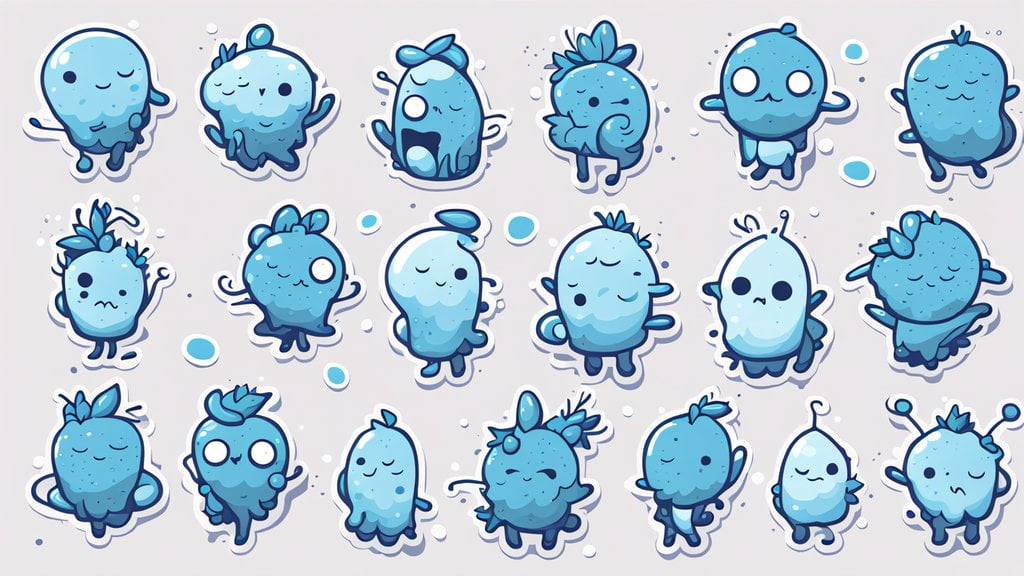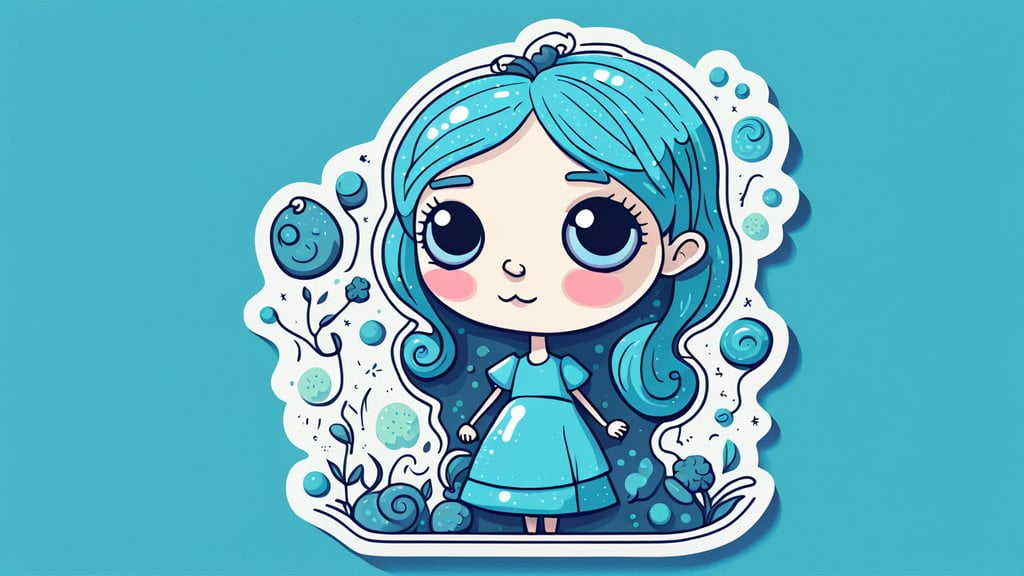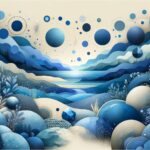The color blue has a fascinating history and a profound impact on our psychology and perception. In this article, we delve into the intriguing world of blue, uncovering captivating fun facts that will leave you amazed. From its role in ancient civilizations to its ability to evoke a sense of calm and tranquility, join us as we explore the history, psychology, and effects of the mesmerizing color blue.

Key Takeaways:
- Blue is the most popular color worldwide.
- Blue is a rare color in nature, especially among plants and animals.
- Blue is believed to stimulate productivity and creative problem-solving.
- Blue is known to suppress appetite and is uncommon in food choices.
- Blue has a calming effect, regulating heart rate and breathing.
- The word “blue” comes from the Old French word “bleu.”
- Blue symbolizes peace and calmness, representing the sky and ocean.
- Ancient Egyptians considered blue as the color of the heavens.
Fun Facts About the Color Blue
Blue is a captivating and enchanting hue that has fascinated humans for centuries. From its historical significance to its effects on human emotions and perceptions, there are plenty of fun facts about the color blue to explore. Let’s dive into the intriguing world of blue!
Blue, the Popular Choice
Did you know that blue is the most popular color worldwide? Its calming and soothing properties make it a favorite among many people[^3]. Whether it’s the color of the sky on a clear day or the vastness of the ocean, blue has a universal appeal that resonates with individuals from diverse cultures.
The Rarity of Blue in Nature
While blue is a prominent color here on Earth, it’s surprisingly rare in nature. Less than 10% of all plants have blue flowers, and only a handful of animals possess shades of blue in their natural coloring[^2]. This rarity adds to the allure and mystique of the color blue.
The Productivity Impetus
If you’re looking to boost productivity and enhance creative problem-solving abilities, blue might just be the color for you. This calming hue has been shown to encourage focus, stimulate innovative thinking, and alleviate stress[^14]. So, for those seeking a productive work environment, incorporating blue into the decor may be a wise choice.
The Surprising Appetite Suppressant
While blue may not be the color you typically associate with food, it has an interesting effect on appetite. Studies suggest that the color blue can actually suppress hunger and help control food intake[^4][^10]. So, if you’re on a diet or watching your calorie intake, eating from blue plates may be beneficial.
The Blue Connection to Calmness
Blue is often associated with tranquility and peace. Its connection to the sky and the ocean, symbolizing vastness and serenity, has been observed in various cultures throughout history[^5]. Ancient Egyptians even considered blue to be the color of the heavens, further solidifying its association with peace and tranquility.
The Etymology of “Blue”
The word “blue” itself has an interesting origin. It comes from the Old French word “bleu,” which derives from the Frankish word “blao.”[^5] This linguistic journey reminds us of the rich history and cultural significance attached to colors.
The color blue is indeed a captivating hue, with its popularity, rarity in nature, productivity-boosting properties, appetite-suppressing effects, associations with calmness, and intriguing etymology. Whether you’re fascinated by its historical significance or intrigued by its psychological impact, blue continues to captivate our minds and hearts.
Sources:
- Feng Shui Dana: 16 Fascinating Facts About Blue
- Just Fun Facts: Interesting Facts About the Color Blue
Here are some fascinating fun facts about Kit Kats that you probably didn’t know! And if you want to delve deeper into the world of Kit Kats, click here to discover more interesting tidbits.
Are you curious about the creators behind your favorite video games? Learn some incredible fun facts about video game designers by clicking here. You won’t believe the amount of creativity and dedication they put into their work!
If you’re an animal lover, you’ll be delighted to explore some fun facts about farm animals. Click here to learn amazing things about the furry and feathered friends that inhabit our farms. Don’t miss out on these intriguing facts!
The Psychological Effects of Blue on Human Emotions
The color blue has a profound impact on our emotions, evoking feelings of calmness, tranquility, and relaxation. Its associations with low stress, low temperature, and low pulse rate make it a symbol of stability and reliability. Blue is often used by businesses that want to project an image of security.
On the other hand, blue can also be associated with sadness or aloofness. Its lack of warmth and emotional distance may create feelings of indifference. However, the psychological effects of blue on human emotions are highly personal and can be influenced by past experiences.
Color Psychology and Human Behavior
Color psychology is a field that explores how different colors affect human mood and behavior. In the case of blue, it has been found that this color can reduce anxiety and depression. It has a balancing effect on the brain and can even affect physiological functions such as heart rate and body temperature[^1^].
The Influence of Blue in Advertising and Marketing
Blue is widely used in advertising and marketing due to its associations with trust, security, and reliability. Research has shown that the color blue can influence consumer behavior, helping to build a sense of trust and encouraging individuals to make purchasing decisions[^1^].
Cultural Variations and Symbolism
It’s important to note that the meaning and symbolism assigned to the color blue can vary based on culture, spirituality, and symbolism. While blue is often associated with tranquility and peace, symbolizing the sky and the ocean, different cultures may have different interpretations and associations with this color[^2^].
With the knowledge of the psychological effects of blue on human emotions, individuals can make informed choices about the use of this color in various aspects of their lives, such as interior design, branding, and personal expressions.
Key Takeaways:
- The color blue evokes feelings of calmness, tranquility, and relaxation.
- Blue is associated with low stress, low temperature, and low pulse rate, symbolizing stability and reliability.
- Blue can also create feelings of sadness or aloofness, with associations of emotional distance and indifference.
- The psychological effects of blue on human emotions are highly personal and can be influenced by past experiences.
- Blue is used in advertising and marketing to build trust and reliability.
- The meaning and symbolism of blue may vary across different cultures and contexts.
Sources:
– ThoughtCo – Color Psychology and Human Behavior
– Verywell Mind – The Color Psychology of Blue
The Impact of Blue on Visual Perception and Cognition
Color perception and cognition are fascinating topics that delve into the depths of human experience. In particular, the color blue has been found to have a significant impact on visual perception and cognition. From its effects on memory performance to its calming and balancing influence on the mind, the color blue is an intriguing subject to explore. So, let’s dive into some fun and insightful facts about the impact of blue on visual perception and cognition!
Blue and Memory Performance
Have you ever wondered how color can affect memory? Research has shown that colors can indeed have a significant impact on memory performance. In fact, studies have demonstrated that blue can lead to better memory performance than other colors (Adawiah Dzulkifli & Mustafar, 2013). But what makes blue so special?
The Relaxing Power of Blue
One of the fascinating aspects of the color blue is its ability to induce a calming and relaxing effect on the mind. It has been found that the blue color of the sea, for example, can reduce anxiety and depression while also promoting a sense of balance within the brain (Exploring Your Mind). So, the next time you find yourself staring at the azure waves of the ocean, remember that the color blue is playing a part in soothing your mind.
The Vast Spectrum of Color Perception
Normal color vision allows us to experience a wide range of colors, with estimates of up to 2.3 million discernable colors (Elliot & Maier, 2014). Each color carries its own meaning and impact on our affect, cognition, and behavior. The perception of color is influenced by various factors, including individual differences and cultural influences. Some individuals may even possess color superpowers or have abnormalities in color perception due to changes in eye physiology (Knowable Magazine, Nature).
Insights into Human Behavior
Understanding the development of color perception and cognition provides valuable insights into human behavior and cognition. Researchers from various fields, such as behaviorism, Gestalt psychology, and cognitive psychology, are continually investigating the intricacies of visual perception. By exploring how color perception and cognition develop, we can gain a deeper understanding of ourselves and the way we interact with the world (Ludlow et al., 2014; Annual Reviews).
Key Takeaways:
- Blue has been found to enhance memory performance, making it a color worth considering when studying or trying to remember important information.
- The color blue can have a calming and balancing effect on the mind, reducing anxiety and promoting relaxation.
- Normal color vision allows us to perceive a vast spectrum of colors, with each color carrying its own meaning and impact on human emotion and perception.
- Investigating color perception and cognition provides valuable insights into human behavior and cognition, shedding light on how we interact with the world around us.
Sources:
– The Influence of Colour on Memory Performance: A Review by Adawiah Dzulkifli and Mustafar M.F.
– The Development of Color Perception and Cognition in Autism Spectrum Disorder: A Review by Ludlow, A. K., Heaton, P., & Hill, E. L.
The usage of blue in art and design throughout history
Blue: A Color of Royalty and Divinity
- Blue was first created by the Ancient Egyptians around 2200 BCE, as they sought a permanent and vibrant pigment for various surfaces.
- Its rarity and unparalleled beauty made blue associated with royalty and divinity throughout history.
- The scarcity of lapis lazuli, the primary source for blue pigments in ancient times, led chemists to develop synthetic blue pigments.
Shades of Blue: Vibrant and Captivating
- Since ancient times, scientists and chemists worldwide have continued to produce an array of blue pigments, creating a diverse spectrum of captivating blues.
- Artists throughout history have utilized these pigments to bring their artworks to life, infusing them with vibrant shades of blue.
The Fascinating History of Blue Pigments
- The history of blue pigments in art is rich and captivating, with the first synthetic pigment, Egyptian blue, being invented around 2200 BCE.
- Artists in Ancient Egypt used blue pigments to decorate their creations, coinciding with the construction of the Great Pyramids.
- Over the centuries, new blue hues have been discovered and integrated into artistic expressions, further expanding the possibilities of blue in art and design.
The Power of Blue: Conveying Emotions and Meanings
- Blue has played a significant role throughout art history in conveying a wide range of emotions and meanings.
- Artists skillfully utilize different shades of blue to evoke various moods and atmospheres in their works.
- Notably, Pablo Picasso’s “blue period” exemplifies how blue can create a subdued and melancholic atmosphere in art.
Blue: Latecomer but Highly Valued
- While blue is one of the seven colors of the rainbow, it was a latecomer in terms of its extensive use in art, decoration, language, and literature.
- However, blue has become an essential and highly valued color in various artistic expressions and decorative arts throughout history.
Key Takeaways:
– Blue, first created by the Ancient Egyptians, has been associated with royalty and divinity due to its rarity and unique beauty.
– Artists have utilized a wide range of blue pigments throughout history to infuse their artworks with vibrant and captivating shades of blue.
– The fascinating history of blue pigments in art stretches back thousands of years, starting with the invention of Egyptian blue.
– The color blue has played a significant role in conveying emotions and meanings in art, allowing artists to evoke different moods and atmospheres.
– Blue, despite being a latecomer among colors, has become an essential and highly valued color in various artistic and decorative expressions.
Sources:
– Inside Colors
– Artsy

FAQ
Q1: Why is blue considered the most popular color globally?
A1: Blue is considered the most popular color globally because it is associated with peace, calmness, and tranquility. It evokes a sense of relaxation and is visually appealing to many people.
Q2: Does blue have any effects on productivity and problem-solving?
A2: Yes, blue is said to encourage productivity and creative problem-solving. It has a calming effect on the mind and can help individuals stay physically calmer, regulating heart rate and breathing.
Q3: Does the color blue affect appetite?
A3: Yes, it is believed that the color blue suppresses appetite. Blue is the least common color among the foods we eat, and its association with calmness and tranquility may contribute to a decreased desire to eat.
Q4: What is the historical significance of the color blue?
A4: The color blue has a rich historical significance. In ancient Egypt, blue was considered the color of the heavens. It was associated with royalty and divinity due to its rarity and unique beauty.
Q5: Why is blue used in office decor schemes?
A5: Blue is often used in office decor schemes because of its association with productivity and creative problem-solving. It is believed to create a calm and focused environment, stimulating productivity in the workplace.
- Unlock Filipino Culture: A Deep Dive into Traditions and Practices - April 23, 2025
- Unlock Spanish Culture: Insights & Opportunities Now - April 23, 2025
- White Spirit Uses & Substitutes: A Deep Dive for Pros & DIYers - April 23, 2025
















